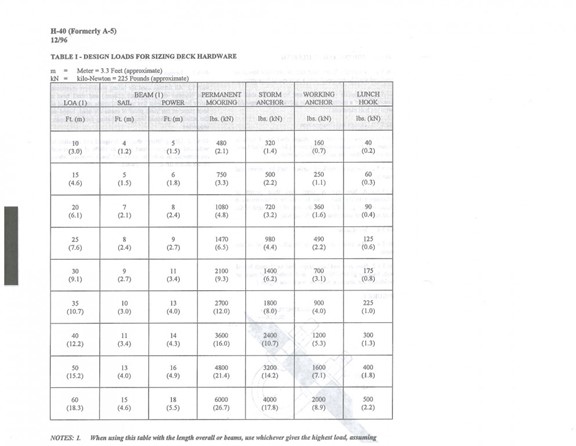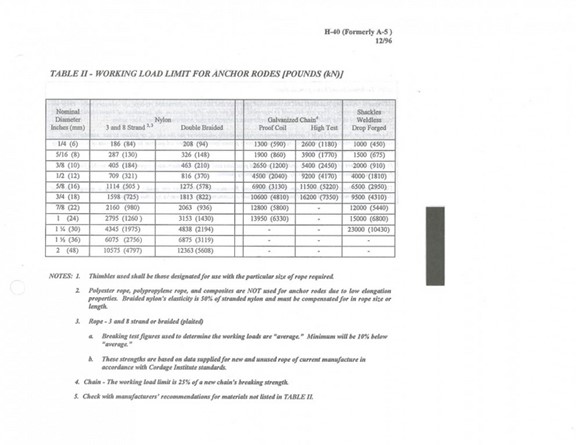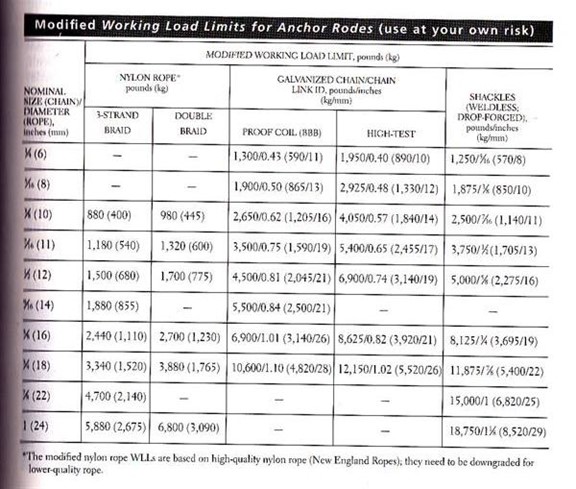Ground Tackle
As I am using the boat more often, to further locations, I decided to investigate the optimal size and characteristics of the ground tackle.
To obtain maximum holding power of the anchor, the total anchor rode should be 4 to 7 times the depth of the water you will be anchoring in.
A good compromise between all-nylon or all-chain rode is a short length of chain (6"-30") connected to the anchor, with a long length of three-strand nylon line connected to the chain. This combination satisfies nearly all requirements of a good anchor rode, except that it is not abrasion resistant over its entire length. Long scope must be used to keep the pull on the anchor shank horizontal. Nylon is preferred for its elasticity. Its stretch reduces peak loads on the anchor and on your boat. The primary function of chain is to handle the chafe from rough bottoms that would otherwise abrade the soft nylon line.
Scope is defined as the ratio of water depth (plus freeboard) to anchor line paid out. Most anchoring texts and anchor manufacturers agree that a scope of 7:1 achieves the anchor's designed holding power, and more scope is better than less. In theory, 7:1 scope is great, but at a crowded anchorage most cruisers scoff at the idea of paying out more than 3:1 or 4:1—there just isn't much space for boats to swing. Any reduction in scope, of course, must be made up for by using larger anchors and/or larger chain.
How much chain you should have in a chain-and-rope anchor rode is not fixed because of the variety of factors involved (boat displacement, draft, surface conditions, etc.). There isn't a set formula for equating the amount of line to chain in an anchor rode.
John Rousmaniere, the noted author of The Annapolis Book of Seamanship, recommends at least six to ten feet of chain accompany every anchor rode (except of course those for dinghies and those that are all-chain), but that's a bare minimum for anything over 25 feet LOA. You could say that twice as much line as chain would keep you safe in almost any situation.
Calculations for the optimum length of chain on a combined nylon chain rode are complex. However William van Dorn in Oceanography and Seamanship; Dodd, Mead (1974), presents a graph based on calculations for anchoring oceanographic vessels in storm conditions. It suggests that the optimum chain/nylon combination for anchoring vessels <50ft. in 30 ft. of water under storm conditions is a 20% chain, 80% nylon rode with an overall scope of 6:1. Assuming that the boat's bow chock is 6 feet above the water and that the waves are 4 feet (8 feet peak to trough) this works out to a 240 foot total rode comprised of 48 feet of chain and 192 feet of nylon. Clearly these are extreme conditions. In shallower water the rode could be reduced proportionately. However, the length of chain required approximates one boat length and a good working rule for a combined rode is a boat length of chain plus whatever nylon is required to give a 6:1 scope. In shallower water, the scope should be increased, within swing limitations, to 7:1 to permit the bow to lift more easily to the choppy waves near the shore.
In summary, at a fixed anchoring depth, the longer the rode, the less chain required. The shortest rodes are achieved with all chain, the heavier the better, but the penalty is increased weight and handling difficulty and the slightly increased possibility of catastrophic failure if the chain stretches taut.
Given this, and other calculations and various analyses and recommendations (see below), I was able to put together a basic set of requirements for Selene:
| Storm | Working | Lunch | |
| Loading | 1,800lbs | 900lbs | 225lbs |
| Chain | >3/8" | 5/16" | 1/4 |
| Rode | 5/8" | 1/2" | 3/8" |
| Anchor | ~35lb | ~22lb | ~10lb |
Pearson323.com recommendations
- 35lb CQR, 300' 5/8" rode, 60' 5/16" chain
- 22lb Bruce, 300", 5/8" rode, 60' 5/16" chain
- 22lb Danforth, 150", 1/2" rode, 30' 5/16" chain
Selene Ground Tackle
1) General use
- 8lb Danforth
- 6" 1/4" chain
- 150" 1/2" 3-strand nylon
2) Working
- 10Kg (22lb) Bruce (25lb Manson Supreme as backup)
- 38 Feet of 5/16" PC Chain, 1900lb. SWL, and (1) 5/16" 1500lb. SWL shackle.
- 150 Feet of 1/2" 3-Strand line pre-spliced to chain
Research
Chain - BBB Short Link
| Size3 | Diameter | Inside Length | Inside Width | Working Load | Weight/ft |
| 1/4" | 0.276" | 0.87" | 0.43" | 1250lb | 0.72 |
| 5/16" | 0.343" | 1.00" | 0.50" | 1900lb | 1.108 |
| 3/8" | 0.406" | 1.10" | 0.62" | 2650lb | 1.639 |
Anchor Rode
Nylon Double Braid is the material of choice for anchor rodes - It has high strength combined with elasticity - Just the properties needed. Braid is more susceptible to chafe than 3-strand, but coils better in the anchor locker.
The following table will help in choosing the correct size for your boat:
BRAID |
3-STRAND |
|||
| Size | Breaking Strength (lb) | Allowable Working (lb) | Breaking Strength (lb) | AllowableWorking (lb) |
| 3/8" | 4,800 | 1,200 | 3,850 | 965 |
| 7/16" | 6,400 | 1,600 | ||
| 1/2" | 8,400 | 2,100 | 5,265 | 1,315 |
| 9/16" | 11,400 | 2,850 | ||
| 5/8" | 15,400 | 3,850 | 9,100 | 2,275 |
Selecting Ground Tackle - Ground Tackle Loads
| Boat Size | Load at 20 knots | Load at 60 knots |
| 600lb | 1,100lb | |
| 26 to 30 ft | 900lb | 1,600lb |
1,285lb |
2,300lb |
|
| 34 to 38 ft | 1,575lb | 2,850lb |
| 39 to 45 ft | 1,975lb | 3,600lb |
From cruisersforum.com
Recommendation: 5/16" chain, 5/8" rode for 32 lb anchor.
See also this thread at cruisersforum.com
Induced Wind Loading
F= (A*Sf*Gf*V^2)/390
Where:
F = Horizontal Force in Pounds
A = Projected Area in Square Feet;
Sf = Shape Factor (.90 for round, 1.10 for Flat Plate);
Gf = Gust Factor (1.10 at Sea Surface);
V = Wind Velocity in MPH (Knots x 1.15)
Loads on tackle and Hardware |
|||||
LOA (feet) |
Beam (B max) |
15 knots |
30 knots |
42 knots |
60 knots |
| 25 | 8 | 125 | 490 | 980 | 1960 |
| 30 | 9 | 175 | 700 | 1400 | 2800 |
35 |
10 |
225 |
900 |
1800 |
3600 |
| 40 | 11 | 300 | 1200 | 2400 | 4800 |
(ABYC)



| BOAT SIZE | ANCHOR WEIGHT | |||||
| Length(ft) | Weight(lbs) | Bruce(lbs) | Danforth*(lbs) | Fortress(lbs) | Plow(lbs) | Yachtsman(lbs) |
| 20-25 | 2,500 | 4.4 | 8-S, 5-H | 4 | 10 | 15 |
| 26-30 | 5,000 | 11 | 13-S, 12-H | 7 | 15 | 25 |
| 31-35 | 10,000 | 11/16.5 | 22-S, 12-H | 7/10 | 20 | 35-40 |
| 36-40 | 15,000 | 16.5 | 22-S, 20-H | 10 | 25 | 50 |
| 41-45 | 20,000 | 22 | 40-S, 20-H | 15 | 35 | 65 |
| 46-50 | 30,000 | 22/44 | 65-S, 35-H | 21 | 45 | 75 |
| 51-60 | 50,000 | 44 | 85-S, 60-H | 32 | 60 | 100 |
Anchor Rode Guide
| BOAT SIZE | ANCHOR RODE | |||
| Length (ft) | Weight (lbs) | Chain (dia.-inch) | Nylon (dia.-inch) | Length (ft) |
| 20-25 | 2,500 | 3/16 | 7/16 | 90 |
| 26-30 | 5,000 | 1/4 | 7/16 | 135 |
| 31-35 | 10,000 | 5/16 | 1/2 | 190 |
| 36-40 | 15,000 | 3/8 | 9/16 | 225 |
| 41-45 | 20,000 | 7/16 | 5/8 | 240 |
| 46-50 | 30,000 | 1/2 | 11/16 | 315 |
| 51-60 | 50,000 | 9/16 | 3/4 | 360 |